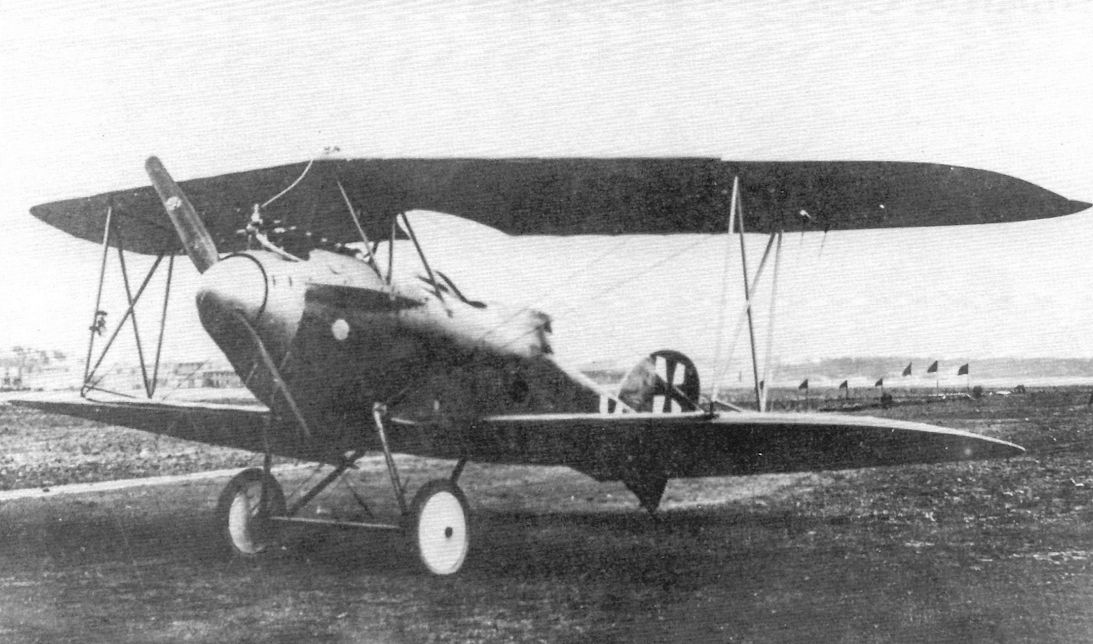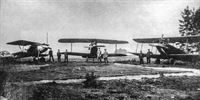
Описание
Страна: Германия
Год: 1917
O.Thetford, P.Gray German Aircraft of the First World War (Putnam)
Albatros C IX
A forerunner of the CL machines, three examples only of the C IX were constructed during 1917. It was of unusual single-bay format for a two-seater, with the top wing considerably swept and the lower wing straight. The fuselage and empennage was similar in construction to that of the famous D types. It is reported that one of the C IXs was presented to Baron Manfred von Richthofen for his use behind the lines as a personal transport. Engine, 160 h.p. Mercedes D III. Span, 10.4 m. (34 ft. 1 1/2 in.). Length, 8.22 m. (26 ft. 11 7/8 in.). Height, 2.735 m. (8 ft. 11 3/4 in.). Weights: Empty, 790 kg. (1,738 lb.). Loaded, 1,150 kg. (2,530 lb.). Speed, 155 km.hr. (96.875 m.p.h.). Climb, 1,000 m. (3,280 ft.) in 5 min., 4,000 m. (13,120 ft.) in 30 min. Duration, ca. 2.5 hr.
Описание:
- O.Thetford, P.Gray German Aircraft of the First World War (Putnam)
- J.Herris Albatros Aircraft of WWI. Vol 2: Late Two-Seaters (A Centennial Perspective on Great War Airplanes 25)
Фотографии
-
J.Herris - Albatros Aircraft of WWI. Volume 2: Late Two-Seaters /Centennial Perspective/ (25)
Albatros C.IX prototype mid 1917.
-
J.Herris - Albatros Aircraft of WWI. Volume 2: Late Two-Seaters /Centennial Perspective/ (25)
Albatros C.IX 4508/16 serving as a squadron 'hack' in JG I and used by Manfred von Richthofen in September/October 1917.
-
J.Herris - Albatros Aircraft of WWI. Volume 2: Late Two-Seaters /Centennial Perspective/ (25)
Albatros C.IX photographed at FliegerAbteilung 12 in February 1918 with lozenge night camouflage on the fuselage and hexagonal night camouflage on the wings and horizontal tail.
-
J.Herris - Albatros Aircraft of WWI. Volume 2: Late Two-Seaters /Centennial Perspective/ (25)
In response to Idflieg’s requirement for a light C-type the Albatros C.IX exhibited excellent workmanship. Design of the C.IX was also more innovative than most Albatros aircraft, although it had a streamlined fuselage characteristic of Albatros aircraft of that time. However, the competing Hannover CL.II was a more compact design that offered better speed and climb and, together with the Halberstadt CL.II, was selected for production in place of the shapely C.IX. (Peter M. Bowers Collection/The Museum of Flight)
-
Jane's All The World Aircraft 1919 /Jane's/
Manfred von Richthofen and Mohnicke in C.IX 4508/16, preparing to takeoff from Hannover after Richthofen's visit.
One of only three Albatros C.IX Type Two-seater biplanes built in 1917, with arrow-shaped wings and curious strutting arrangement. -
J.Herris - Albatros Aircraft of WWI. Volume 2: Late Two-Seaters /Centennial Perspective/ (25)
The Albatros C.IX used the technology of the Albatros fighters. It was designed to meet Idflieg's specification for a light C-type. Over-shadowed by the competing designs from Halberstadt and Hannover, it did not go into production. Manfred von Richthofen used this example for personal transportation and is seen here in the rear cockpit.
-
J.Herris - Albatros Aircraft of WWI. Volume 1: Early Two-Seaters /Centennial Perspective/ (24)
The Albatros C.IX was a compact aircraft built to the requirement for a light C-type (later called CL-type) for use as an escort fighter and ground attack aircraft.The design was clearly influenced by Albatros fighters.
The sole Albatros C IX of early 1917 was one of a number of prototypes submitted against the need for an armoured close air support type, shortly to be given their own CL designation to identify their specialised ground attack capability. As it transpired, the Junkers J I was to sweep all competition aside and, thus, the lone Albatros passed into the hands of Baron Manfred von Richthofen, for use as his personal transport. The 160 hp Mercedes D III powered C IX had a top level speed of 96.3mph. -
J.Herris - Albatros Aircraft of WWI. Volume 2: Late Two-Seaters /Centennial Perspective/ (25)
Richthofen in the front cockpit of 4508/16, preparing for flight with Mohnicke. The Albatros C.IX had a fairing before the front cockpit that blocked the wind, the clear panels of which allowed light to enter the cockpit.
-
J.Herris - Albatros Aircraft of WWI. Volume 2: Late Two-Seaters /Centennial Perspective/ (25)
Richthofen being assisted into his flight gear prior to boarding Albatros C.IX 4508/16. Note he is wearing the localized strapped-on bandage.
-
H.Cowin - Aviation Pioneers /Osprey/
Germany's leading World War I fighter ace, Baron Manfred von Richthofen, went to war in August 1914 as a young lieutenant in a lancer regiment, aged twenty two. Only at the close of 1914 did he succeed in transferring to the Army Air Service, where, as with many other fighter aces to be, he cut his aviation teeth first training and then operating as an observer. Indeed, it is generally held that although officially unconfirmed, his first 'kill' was made against a Farman from the rear of a two seater. Even after gaining his wings on Christmas Day 1915, the young flier was to remain piloting two seaters for much of 1916. It was during this period that he was to meet the father of German fighter tactics, Oswald Boelcke. Clearly something about Richthofen impressed Boelcke, who subsequently invited him to join his newly formed fighter squadron, or Jagdstaffel 2. Here, Richthofen was one of four to fly the unit's first mission on 17 September 1916, setting him on a course that was to see him credited with 80 victories, before he and his scarlet Fokker Dr I were to meet their end on 21 April 1918. The Baron scored official victory number 16 on January 4 1917 and received the Pour Le Merite twelve days later as the new leader of Jasta 2 (at that time the medal was awarded for 16 kills). The picture captures the young Baron about to climb into his personal transport, which, ironically, was the sole prototype Albatros C IX, presented to him after its failure to gain full operational acceptance.
-
J.Herris - Albatros Aircraft of WWI. Volume 2: Late Two-Seaters /Centennial Perspective/ (25)
Richthofen in the front cockpit of Albatros C.IX 4508/16 at Hannover, Germany, ca. Sept/Oct, 1917.
-
J.Herris - Albatros Aircraft of WWI. Volume 2: Late Two-Seaters /Centennial Perspective/ (25)
Colorized view of Richthofen in Albatros C.IX 4508/16 at Hannover, Germany, ca. Sept/Oct, 1917.
-
J.Herris - Albatros Aircraft of WWI. Volume 2: Late Two-Seaters /Centennial Perspective/ (25)
Albatros C.IX 4508/16 photographed during Manfred von Richthofen's stop-over at Hannover.
-
J.Herris - Albatros Aircraft of WWI. Volume 2: Late Two-Seaters /Centennial Perspective/ (25)
Lothar von Richthofen (right) and his future wife, Countess Doris von Keyserlingk, sit in the cockpits of Manfred von Richthofen's red-painted Albatros C.IX.The Countess appears to be sceptical of flying.
-
J.Herris - Albatros Aircraft of WWI. Volume 2: Late Two-Seaters /Centennial Perspective/ (25)
Albatros C.IX photographed at FliegerAbteilung 12 in February 1918. Idflieg normally ordered three prototypes of experimental aircraft, one for flight testing, one for structural testing, and a spare. The structural test airframe was normally tested to destruction, leaving two flyable airframes. Manfred von Richthofen used one as a transport, and here is the other. Being continually short of aircraft the German Navy often assigned prototypes to operational service; that was much less common for the Army. Regardless, here is a C.IX prototype at an operational unit - and it night camouflage. Was it used for light bombing? Night fighting? Night reconnaissance? Or all those roles? (Peter M. Grosz Collection/SDTB)
-
J.Herris - Albatros Aircraft of WWI. Volume 2: Late Two-Seaters /Centennial Perspective/ (25)
Camouflaged Albatros C.IX in front of a hangar, probably photographed at FliegerAbteilung 12 in February 1918. (Peter M. Grosz Collection/SDTB)
-
J.Herris - Albatros Aircraft of WWI. Volume 2: Late Two-Seaters /Centennial Perspective/ (25)
Albatros C.IX in center of a lineup, probably photographed at FliegerAbteilung 12 in February 1918.
The Albatros C.IX was a compact design for a two-seat fighter for protection and light ground attack duties. Its comparative size vis a vis the Albatros D.V (left) is well shown. With only three C.IXs built, this example is the only one to see frontline service. Note the lengthened flame-damping exhaust indicating possible nighttime use.Другие самолёты на фотографии: Albatros D.V/D.Va - Германия - 1917
-
J.Herris - Albatros Aircraft of WWI. Volume 2: Late Two-Seaters /Centennial Perspective/ (25)
Richthofen's Albatros C.IX 4508/16 on display in the 1930 at the Deutsche Luftfahrt Sammlung without tires. This view emphasizes its compact dimensions.
-
J.Herris - Albatros Aircraft of WWI. Volume 2: Late Two-Seaters /Centennial Perspective/ (25)
Albatros C.IX 4508/16 in a post-war museum. Legends painted on the fuselage state Reisenflugzeug des Rittm. Manfred Freiherr v Richthofen ("Travel plane of Rittmeister Manfred Freiherr von Richthofen") and Kriegsflugzeug fur Fernaufklarung Alb. C.IX 1916/17 ("War plane for reconnaissance Alb. C.IX [the years of] 1916/17"). (Courtesy of the DEHLA Collection)
-
J.Herris - Albatros Aircraft of WWI. Volume 2: Late Two-Seaters /Centennial Perspective/ (25)
The nose of Albatros C.IX 4508/16 shows at left in this photo taken in a post-war museum.
-
J.Herris - Albatros Aircraft of WWI. Volume 2: Late Two-Seaters /Centennial Perspective/ (25)
Albatros C.IX 4508/16 taking off from Hannover after Manfred von Richthofen's visit.
-
J.Herris - Albatros Aircraft of WWI. Volume 2: Late Two-Seaters /Centennial Perspective/ (25)
Albatros C.IX 4508/16 in flight. Although not confirmed, Richthofen may be at the controls. Note the marked sweepback of the upper wings.




























